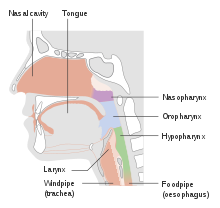| Head and neck cancer | |
|---|---|
| Other names | head and neck squamous cell carcinoma |
 | |
| Parts of the head and neck that can be affected by cancer. | |
| Specialty | Oncology, oral and maxillofacial surgery |
| Risk factors | Alcohol, tobacco, betel quid, human papillomavirus, radiation exposure, certain workplace exposures, Epstein–Barr virus[1][2] |
| Diagnostic method | Tissue biopsy[1] |
| Prevention | Not using tobacco or alcohol[2] |
| Treatment | Surgery, radiation therapy, chemotherapy, targeted therapy[1] |
| Frequency | 5.5 million (affected during 2015)[3] |
| Deaths | 379,000 (2015)[4] |
Head and neck cancer is a general term encompassing multiple cancers that can develop in the head and neck region. These include cancers of the mouth, tongue, gums and lips (oral cancer), voice box (laryngeal), throat (nasopharyngeal, oropharyngeal,[1] hypopharyngeal), salivary glands, nose and sinuses.[5]
Head and neck cancer can present a wide range of symptoms depending on where the cancer developed. These can include an ulcer in the mouth that does not heal, changes in the voice, difficulty swallowing, red or white patches in the mouth, and a neck lump.[6][7]
The majority of head and neck cancer is caused by the use of alcohol or tobacco (including smokeless tobacco). An increasing number of cases are caused by the human papillomavirus (HPV).[8][2] Other risk factors include the Epstein–Barr virus, chewing betel quid (paan), radiation exposure, poor nutrition and workplace exposure to certain toxic substances.[8] About 90% are pathologically classified as squamous cell cancers.[9][2] The diagnosis is confirmed by a tissue biopsy.[8] The degree of surrounding tissue invasion and distant spread may be determined by medical imaging and blood tests.[8]
Not using tobacco or alcohol can reduce the risk of head and neck cancer.[2] Regular dental examinations may help to identify signs before the cancer develops.[1] The HPV vaccine helps to prevent HPV-related oropharyngeal cancer.[10] Treatment may include a combination of surgery, radiation therapy, chemotherapy, and targeted therapy.[8] In the early stage head and neck cancers are often curable but 50% of people see their doctor when they already have an advanced disease.[11]
Globally, head and neck cancer accounts for 650,000 new cases of cancer and 330,000 deaths annually on average. In 2018, it was the seventh most common cancer worldwide, with 890,000 new cases documented and 450,000 people dying from the disease.[12] The usual age at diagnosis is between 55 and 65 years old.[13] The average 5-year survival following diagnosis in the developed world is 42–64%.[13][14]
- ^ a b c d e Cite error: The named reference
NCIwas invoked but never defined (see the help page). - ^ a b c d e World Cancer Report 2014. World Health Organization. 2014. pp. Chapter 5.8. ISBN 978-92-832-0429-9.
- ^ Vos T, Allen C, Arora M, Barber RM, Bhutta ZA, Brown A, et al. (GBD 2015 Disease and Injury Incidence and Prevalence Collaborators) (October 2016). "Global, regional, and national incidence, prevalence, and years lived with disability for 310 diseases and injuries, 1990-2015: a systematic analysis for the Global Burden of Disease Study 2015". Lancet. 388 (10053): 1545–1602. doi:10.1016/S0140-6736(16)31678-6. PMC 5055577. PMID 27733282.
- ^ Wang H, Naghavi M, Allen C, Barber RM, Bhutta ZA, Carter A, et al. (GBD 2015 Mortality and Causes of Death Collaborators) (October 2016). "Global, regional, and national life expectancy, all-cause mortality, and cause-specific mortality for 249 causes of death, 1980-2015: a systematic analysis for the Global Burden of Disease Study 2015". Lancet. 388 (10053): 1459–1544. doi:10.1016/s0140-6736(16)31012-1. PMC 5388903. PMID 27733281.
- ^ Aupérin A (May 2020). "Epidemiology of head and neck cancers: an update". Current Opinion in Oncology. 32 (3): 178–186. doi:10.1097/CCO.0000000000000629. PMID 32209823. S2CID 214644380.
- ^ Cite error: The named reference
:11was invoked but never defined (see the help page). - ^ "Head and neck cancer". NHS. 2017-10-18. Retrieved 2024-06-04.
- ^ a b c d e "Head and Neck Cancers". NCI. 29 March 2017. Retrieved 7 February 2021.
- ^ Vigneswaran N, Williams MD (May 2014). "Epidemiologic trends in head and neck cancer and aids in diagnosis". Oral and Maxillofacial Surgery Clinics of North America. 26 (2): 123–141. doi:10.1016/j.coms.2014.01.001. PMC 4040236. PMID 24794262.
- ^ Cite error: The named reference
:13was invoked but never defined (see the help page). - ^ Cite error: The named reference
:14was invoked but never defined (see the help page). - ^ Chow LQ (January 2020). "Head and Neck Cancer". The New England Journal of Medicine. 382 (1): 60–72. doi:10.1056/nejmra1715715. PMID 31893516. S2CID 209482428.
- ^ a b "SEER Stat Fact Sheets: Oral Cavity and Pharynx Cancer". SEER. April 2016. Archived from the original on 15 November 2016. Retrieved 29 September 2016.
- ^ Beyzadeoglu M, Ozyigit G, Selek U (2014). Radiation Therapy for Head and Neck Cancers: A Case-Based Review. Springer. p. 18. ISBN 978-3-319-10413-3. Archived from the original on 2017-09-10.